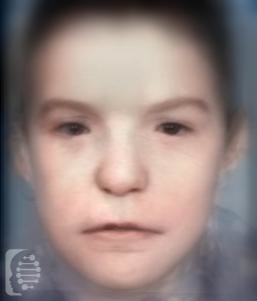What is Blepharonasofacial Malformation syndrome?
Blepharonasofacial Malformation syndrome, also referred to as Pashayan syndrome, is an extremely rare genetic condition, with only three cases reported globally to date.
This rare disease is defined by its unique facial features, which include a mask-like face, and by severe intellectual disability.
This syndrome is also known as:
Pashayan Syndrome
What gene change causes Blepharonasofacial Malformation syndrome?
These are as yet unidentified as research is still ongoing into this incredibly rare condition. It is believed to be inherited in an autosomal dominant pattern, and possibly an X-linked dominant pattern.
In the case of autosomal dominant inheritance, just one parent is the carrier of the gene mutation, and they have a 50% chance of passing it onto each of their children. Syndromes inherited in an autosomal dominant inheritance are caused by just one copy of the gene mutation.
With syndromes inherited in an X-linked dominant pattern, a mutation in just one of the copies of the gene, causes the syndrome. This can be in one of the female X chromosomes, and in the one X chromosomes males have. Males tend to have more severe symptoms than females.
What are the main symptoms of Blepharonasofacial Malformation syndrome?
The syndrome causes individuals to have a mask-like face that prevents them from showing emotion. This is due to weak facial muscles.
Other unique facial features of the syndrome include a broad nasal bridge and a flat and bulky nose. The ears may also not develop properly. Individuals also have blocked lacrimal or tear ducts.
Severe intellectual disability is a major symptom of the syndrome.
Possible clinical traits/features:
Autosomal dominant inheritance, Optic atrophy, Non-midline cleft lip, Hearing impairment, Hernia of the abdominal wall, Cognitive impairment, Underdeveloped nasal alae, Hyperreflexia, Telecanthus, Reduced number of teeth, Torsion dystonia, Mask-like facies, Low posterior hairline, Long philtrum, Intellectual disability, Joint hypermobility, Sparse lateral eyebrow, Blepharophimosis, Abnormality of the voice, Abnormal eyelash morphology, Lacrimation abnormality, Thickened skin, Cutis laxa, Cryptorchidism, Cleft palate, Epicanthus, Finger syndactyly, External ear malformation, Facial palsy.
How is it diagnosed?
To find out if someone has a diagnosis of Blepharonasofacial Malformation syndrome, it is important to have a consultation and evaluation with a clinical genetic specialist. Specialists may also suggest specific genetic testing or other types of tests to help reach a diagnosis. FDNA’s AI technology can help speed up the diagnostic process by analyzing facial features and other health information.

